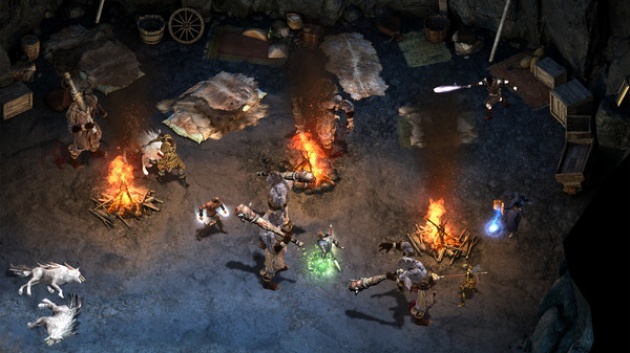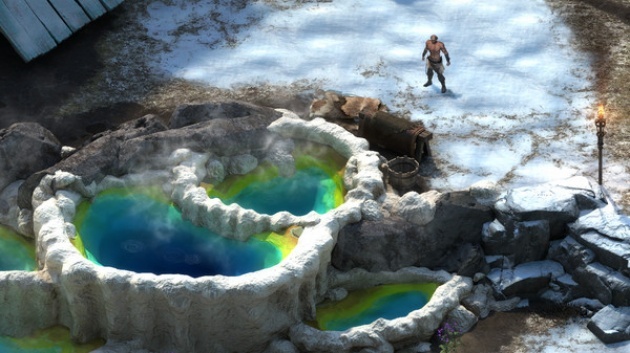Pillars of Eternity: The White March Part I (PC) Review
By Jordan Hurst  07.10.2015
07.10.2015

With its unorthodox yet cohesive combat mechanics and believable, mature narrative, Pillars of Eternity turned out to be one of the best RPGs in recent memory. Nevertheless, its relatively small budget, coupled with its enormous size, left some inevitable room for improvement. Now, with the release of the first half of The White March expansion duology, Obsidian Entertainment had the opportunity to start filling in some of those cracks…and it largely ignored it.
Of course, being essentially a mission pack, this expansion still gets a solid recommendation for devout fans of the base title's gameplay. The intensely tactical combat remains, with all of its systemic reinventions in tow, the side-quests and dialogue options continue the setting's "shades of grey" morality, and the design and structure are still full of brilliant little decisions. In addition to malleable difficulty settings and a fast-forward button, the use of post-battle regenerating health, mixed with the possibility of permanent character death, prevents the combat from ever getting stale because every encounter feels like a boss battle. The problem is that a game that does all those things already exists, and it's already owned by everyone considering purchasing The White March Part I.

There is some new content (as opposed to simply additional content), but much of it feels like an afterthought. The first original feature is soulbound weapons - armaments that, once linked to specific characters, gain new abilities as unique objectives are completed. Next, the stealth mechanics have been altered to allow multiple party members the opportunity for sneak attacks at the start of combat, rather than just the first one to land a hit. There are also new party AI controls that attempt to mitigate micromanagement, and the ability to redesign character builds from Level 1 (for a fee). To go along with this, two new party members can be recruited, characters now have access to minor techniques from classes other than their own, and the level cap has been raised to 14, bringing with it new spells and abilities.
A lot of that sounds pretty great and, indeed, probably should have been included in the original product, but the implementation leaves much of it a wasted opportunity. There are only four soulbound weapons available - not even enough to arm an entire party, and the AI controls are so shallow that they are practically worthless. Other than stealth, no attempt was made to fix some of the base's imperfections, either. Traps and scrolls are still fairly useless inclusions, and the extensive stronghold feature still holds virtually no purpose except as an elaborate checklist. Most exasperatingly, the two new characters have even less connection to the plot than the largely inconsequential established ones, and one of them doesn't even have an associated side-quest like all the others do.

The White March Part I is an excellent example of how much context affects the enjoyment of an experience. Pillars of Eternity's ending would have required some major retcons to allow an expansion to follow it, so this one canonically takes place in the middle of the main story. Aside from its lack of novelty, most of its problems arise from that fact. For one thing, the zig-zagging progression warps the overall difficulty curve. Although the new locations offer to scale up their enemy levels for players who are already beyond the recommended power, this doesn't take into account the vast wealth and unparalleled equipment that endgame gamers will have accumulated. Conversely, tackling all the content in the recommended order will diminish the challenge of the main adventure's second half, thanks to the bolstered level cap.
Furthermore, while Pillars of Eternity was a tribute to the games of the Infinity Engine in general, The White March Part I feels like a tribute to Icewind Dale specifically, due to its hub town structure, snowy setting, minimal plot, and, by extension, minimal significance. As an extended side-quest with a single lengthy dungeon as its centrepiece, the story is inevitably anticlimactic. Aside from a hint of what's to come in Part II, it's very straightforward: the party arrives in the territory of the White March, deciphers how to enter a previously impenetrable ancient structure, explores its depths, and then continues on its way. Still, Obsidian has always treated writing as an integral part of its experiences, so the story is at least told wonderfully.

It's for these reasons that the various events and smaller quests around the primary dungeon are actually more interesting than the dungeon itself. Of particular note is a section that repurposes the protagonist's ability to glimpse others' past lives by asking for reincarnations of specific people to be found. Originally, this mechanic was mainly used as a medium for inconsequential short stories by Kickstarter donators, but by tying it to a quest (and a unique one at that), it's been made both more relevant and more engaging. The other artistic elements didn't receive any such reinvention, but they also didn't need it as much. The White March is just as beautifully illustrated and inhabited by poorly detailed 3D models as the rest of Eora, and the soundtrack and voice acting remain exquisite and satisfactory, respectively.

Cubed3 Rating
Good
If, for some reason, the 50-100 hours of content in Pillars of Eternity were not enough for some people, The White March Part I will fulfil their needs. However, "expansion" seems like too generous a word for what it is. "Expansion" implies branching out into new territory; all this DLC does is cycle back for another lap in the same territory. Pillars of Eternity's flaws, as few in number as they were, are a lot more noticeable when they are not accompanied by some amount of novelty or narrative import.

![]() 8/10
8/10
![]() 0
(0 Votes)
0
(0 Votes)
 Out now
Out now  Out now
Out now  None
None  Out now
Out now Comments
Comments are currently disabled

 Sign In
Sign In Game Details
Game Details Subscribe to this topic
Subscribe to this topic Features
Features





 Top
Top

